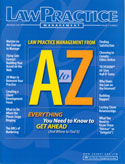Finding the right online course can be a neat experience, despite the drawbacks.
By Erik J. Heels
First published 7/1/2001; Law Practice Management magazine, “nothing.but.net” column; American Bar Association
 Call it the seven-year itch. But after writing dozens of articles and a few books over the past years about how lawyers can use technology to market and practice law, I’ve decided to practice what I’ve been preaching and resume my patent law practice, which I put on hold immediately after law school to pursue opportunities in the Internet marketspace.
Call it the seven-year itch. But after writing dozens of articles and a few books over the past years about how lawyers can use technology to market and practice law, I’ve decided to practice what I’ve been preaching and resume my patent law practice, which I put on hold immediately after law school to pursue opportunities in the Internet marketspace.
Finding It
One of the first things I decided to do was to take an online CLE course. My first challenge was to find and choose a CLE provider. I started with CLE providers that I knew about.
The first company that came to mind was CLE Online.com (http://www.cleonline.com/). CLE Online.com listed about 70 courses, including two on patent issues, but neither of those was on point with what I wanted to study.
The ABA Center for Continuing Legal Education offers online CLE and has about 50 courses online (http://www.abanet.org/cle/ecle/home.html), including four on intellectual property topics, but these were not exactly on point with what I wanted to study.
The American Intellectual Property Law Association (http://www.aipla.org/) publishes excellent white papers and briefs on current topics, and the Boston Patent Bar Association (http://www.bpla.org/) has good local events, but neither offers online CLE.
I then continued searching for other providers. I searched Google (http://www.google.com/) for “‘online CLE’ AND patent'” and found a good summary online CLE providers from About.com (http://lawyers.about.com/careers/lawyers/library/weekly/aa031398.htm).
That article included information about several other CLE providers such as ALI-ABA (http://www.ali-aba.org/), Law.com (http://store.law.com/seminars/), LawyersEd.com (http://www.lawyersed.com/), and Practising Law Institute (PLI) (http://www.pli.edu/), and Taecan.com (http://www.taecan.com/).
I was more familiar with some of the CLE providers than with others. Ultimately, I selected PLI, because the topic (patent law) and the format (streaming video) were what I was looking for. Plus colleague had recommended PLI as a reliable provider of high-quality programs.
Testing Your Technology
I was fairly confident that using streaming video would not be a problem because I have a DSL connection. But would it be fast enough for streaming video? I measured my bandwidth at DSLreports (http://www.dslreports.com/stest/) and 2Wire (http://www.2wire.com/dlp/dlp_bandwidth.html). My DSL connection clocked in over 150 KBps with both sites. I honestly don’t know how fast my Internet connection is supposed to be. All I know is that my connection always seems fast enough.
Doing It
I headed to PLI’s web site and purchased my program. Programs are available as streaming video (for higher speed connection) or streaming audio (for lower speed connections). I find it easier to follow a presentation when I can watch the speaker and his other body language, so I chose the video format.
On my first day, I watched over four hours of video and never once had any problem with the transmission. I was truly stunned with just how well everything worked!
There were some unpleasant surprises, however. Presentation of the print materials was poor. As I started the program, I was told to refer to a PDF file that I was supposed to have downloaded and printed before I started the course. That PDF file was over 100 pages long. I frequently had to pause the presentation to give my printer a chance to catch up. In addition, one page on PLI’s site listed the materials in one order, another in another order. There were typos and spelling errors, the Q&A materials were not included in the printed materials, and at least one file was missing from the materials. Users shouldn’t have to spend time printing out 50 separate files. At the very least, each program’s materials should be archived in a ZIP file for easy downloading. They should also be combined into a single PDF file with an index and page numbers.
There were also some technical issues. There was at least one broken URL, some missing JavaScript code that prevented one session from starting, and one video file that had become corrupted. I contacted PLI’s online support department by phone and by e-mail, and each time they fixed the problems quickly, usually within minutes. I now know that I can expect excellent customer support from PLI, and that will make me likely to return for more programs in the future.
When I review a web site, I consider three things: content (i.e. the quality of the data), presentation (i.e. the packaging of the data into web pages and other formats) and experience (i.e. the user-friendliness of the site). PLI scores very high marks for content. These courses are concise, relevant, and worth the money. The poor organization of the print materials, however, was a distraction, and I spent much too much time on printing and organizing the materials, especially considering how much I paid for the program. Overall, my experience with online CLE was positive, and PLI’s support department was an essential part of that equation.


